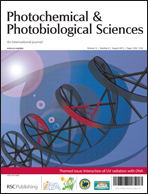UVA1 exerts its genotoxicity on mammalian skin by producing cyclobutane pyrimidine dimers (CPDs) in DNA and preferentially inducing solar-UV-signature mutations, C → T base substitution mutations at methylated CpG-associated dipyrimidine (Py-mCpG) sites, as demonstrated previously using a 364 nm laser as a UVA1 source and lacZ-transgenic mice that utilize the transgene as a mutational reporter. In the present study, we confirmed that a broadband UVA1 source induced the same mutation profiles in mouse epidermis as the UVA1 laser, generalizing the previous result from a single 364 nm to a wider wavelength range of UVA1 (340–400 nm). Combined with our previous data on the mutation spectra induced in mouse epidermis by UVB, UVA2 and solar UVR, we proved that the solar-UV-signature mutation is commonly observed in the wavelength range from UVB to UVA, and found that UVA1 induces this mutation more preferentially than the other shorter wavelength ranges. This finding indicates that the solar-UV-signature mutation-causing CPDs, which are known to prefer Py-mCpG sites, could be produced with the energy provided by the longer wavelength region of UVR, suggesting a photochemical reaction through the excitation of pyrimidine bases to energy states that can be accomplished by absorption of even low-energy UVR. On the other hand, the lower proportions of solar-UV-signature mutations observed in the mutation spectra for UVB and solar UVR indicate that the direct photochemical reaction through excited singlet state of pyrimidine bases, which can be accomplished only by high-energy UVR, is also involved in the mutation induction at those shorter wavelengths of UVR. We also found that the solar-UV signature prefers 5′-TCG-3′ to 5′-CCG-3′ as mutational target sites, consistent with the fact that UVA induces CPDs selectively at thymine-containing dipyrimidine sites and that solar UVR induces them preferably at Py-mCpG sites. However, the mutation spectrum in human p53 gene from non-melanoma skin cancers shows the opposite preference for 5′-CCG-3′ sites. This apparent discrepancy in the site preference seems to result from the lack of 5′-TCG-3′ sites mutable to missense mutations on the nontranscribed strand of human p53 gene, which should be evolutionally acquired under selective pressure from the sun.


 Please wait while we load your content...
Please wait while we load your content...